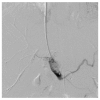Transjugular intrahepatic portosystemic shunt with covered stents for hepatocellular carcinoma with portal vein tumor thrombosis
- PMID: 24587637
- PMCID: PMC3925870
- DOI: 10.3748/wjg.v20.i6.1602
Transjugular intrahepatic portosystemic shunt with covered stents for hepatocellular carcinoma with portal vein tumor thrombosis
Abstract
Aim: To evaluate transjugular intrahepatic portosystemic shunt (TIPS) with covered stents for hepatocellular carcinoma (HCC) with main portal vein tumor thrombus (PVTT).
Methods: Eleven advanced HCC patients (all male, aged 37-78 years, mean: 54.3 ± 12.7 years) presented with acute massive upper gastrointestinal bleeding (n = 9) or refractory ascites (n = 2) due to tumor thrombus in the main portal vein. The diagnosis of PVTT was based on contrast-enhanced computed tomography and color Doppler sonography. The patients underwent TIPS with covered stents. Clinical characteristics and average survival time of 11 patients were analyzed. Portal vein pressure was assessed before and after TIPS. The follow-up period was 2-18 mo.
Results: TIPS with covered stents was successfully completed in all 11 patients. The mean portal vein pressure was reduced from 32.0 to 11.8 mmHg (t = 10.756, P = 0.000). Gastrointestinal bleeding was stopped in nine patients. Refractory ascites completely disappeared in one patient and was alleviated in another. Hepatic encephalopathy was observed in six patients and was resolved with drug therapy. During the follow-up, ultrasound indicated the patency of the shunt and there was no recurrence of symptoms. Death occurred 2-14 mo (mean: 5.67 mo) after TIPS in nine cases, which were all due to multiple organ failure. In the remaining two cases, the patients were still alive at the 16- and 18-mo follow-up, respectively.
Conclusion: TIPS with covered stents for HCC patients with tumor thrombus in the main portal vein is technically feasible, and short-term efficacy is favorable.
Keywords: Covered stent; Hepatocellular carcinoma; Main portal vein tumor thrombus; Portal hypertension; Transjugular intrahepatic portosystemic shunt.
Figures



Similar articles
-
Efficacy and safety of transjugular intrahepatic portosystemic shunt in patients with hepatocellular carcinoma-A systematic review and meta-analysis.Indian J Gastroenterol. 2024 Dec;43(6):1121-1135. doi: 10.1007/s12664-024-01646-7. Epub 2024 Aug 10. Indian J Gastroenterol. 2024. PMID: 39126599
-
Combined transjugular intrahepatic portosystemic shunt and other interventions for hepatocellular carcinoma with portal hypertension.World J Gastroenterol. 2015 Nov 21;21(43):12439-47. doi: 10.3748/wjg.v21.i43.12439. World J Gastroenterol. 2015. PMID: 26604651 Free PMC article.
-
Transjugular Intrahepatic Portosystemic Shunt for Portal Hypertension in Hepatocellular Carcinoma with Portal Vein Tumor Thrombus.Cardiovasc Intervent Radiol. 2017 Sep;40(9):1372-1382. doi: 10.1007/s00270-017-1655-8. Epub 2017 May 9. Cardiovasc Intervent Radiol. 2017. PMID: 28488102
-
Percutaneous transhepatic intrahepatic portosystemic shunt for variceal bleeding with chronic portal vein occlusion after splenectomy.Eur Radiol. 2018 Sep;28(9):3661-3668. doi: 10.1007/s00330-018-5360-z. Epub 2018 Mar 29. Eur Radiol. 2018. PMID: 29600476
-
[Transjugular intrahepatic portosystemic stent shunt: indications and long-term outcome].Zentralbl Chir. 2005 Jun;130(3):246-9. doi: 10.1055/s-2005-836547. Zentralbl Chir. 2005. PMID: 15965878 Review. German.
Cited by
-
Clinical application of combined laparoscopic surgery in the treatment of primary hepatocellular carcinoma with portal hypertension: a report of 16 cases.Transl Cancer Res. 2019 Feb;8(1):330-337. doi: 10.21037/tcr.2019.01.23. Transl Cancer Res. 2019. PMID: 35116762 Free PMC article.
-
Efficacy and safety of transjugular intrahepatic portosystemic shunt in patients with hepatocellular carcinoma-A systematic review and meta-analysis.Indian J Gastroenterol. 2024 Dec;43(6):1121-1135. doi: 10.1007/s12664-024-01646-7. Epub 2024 Aug 10. Indian J Gastroenterol. 2024. PMID: 39126599
-
Risks and benefits of TIPS in HCC and other liver malignancies: a literature review.BMC Gastroenterol. 2023 Nov 20;23(1):403. doi: 10.1186/s12876-023-03047-0. BMC Gastroenterol. 2023. PMID: 37986043 Free PMC article. Review.
-
Combined transjugular intrahepatic portosystemic shunt and other interventions for hepatocellular carcinoma with portal hypertension.World J Gastroenterol. 2015 Nov 21;21(43):12439-47. doi: 10.3748/wjg.v21.i43.12439. World J Gastroenterol. 2015. PMID: 26604651 Free PMC article.
-
Transjugular intrahepatic portosystemic shunt in patients with hepatocellular carcinoma: A systematic review.United European Gastroenterol J. 2023 Oct;11(8):733-744. doi: 10.1002/ueg2.12454. Epub 2023 Sep 22. United European Gastroenterol J. 2023. PMID: 37736854 Free PMC article.
References
-
- García-Pagán JC, Caca K, Bureau C, Laleman W, Appenrodt B, Luca A, Abraldes JG, Nevens F, Vinel JP, Mössner J, Bosch J. Early use of TIPS in patients with cirrhosis and variceal bleeding. N Engl J Med. 2010;362:2370–2379. - PubMed
-
- Riggio O, Ridola L, Angeloni S, Cerini F, Pasquale C, Attili AF, Fanelli F, Merli M, Salvatori FM. Clinical efficacy of transjugular intrahepatic portosystemic shunt created with covered stents with different diameters: results of a randomized controlled trial. J Hepatol. 2010;53:267–272. - PubMed
-
- Bureau C, Garcia-Pagan JC, Otal P, Pomier-Layrargues G, Chabbert V, Cortez C, Perreault P, Péron JM, Abraldes JG, Bouchard L, Bilbao JI, Bosch J, Rousseau H, Vinel JP. Improved clinical outcome using polytetrafluoroethylene-coated stents for TIPS: results of a randomized study. Gastroenterology. 2004;126:469–475. - PubMed
-
- Bureau C, Pagan JC, Layrargues GP, Metivier S, Bellot P, Perreault P, Otal P, Abraldes JG, Peron JM, Rousseau H, Bosch J, Vinel JP. Patency of stents covered with polytetrafluoroethylene in patients treated by transjugular intrahepatic portosystemic shunts: long-term results of a randomized multicentre study. Liver Int. 2007;27:742–747. - PubMed
Publication types
MeSH terms
LinkOut - more resources
Full Text Sources
Other Literature Sources
Medical

